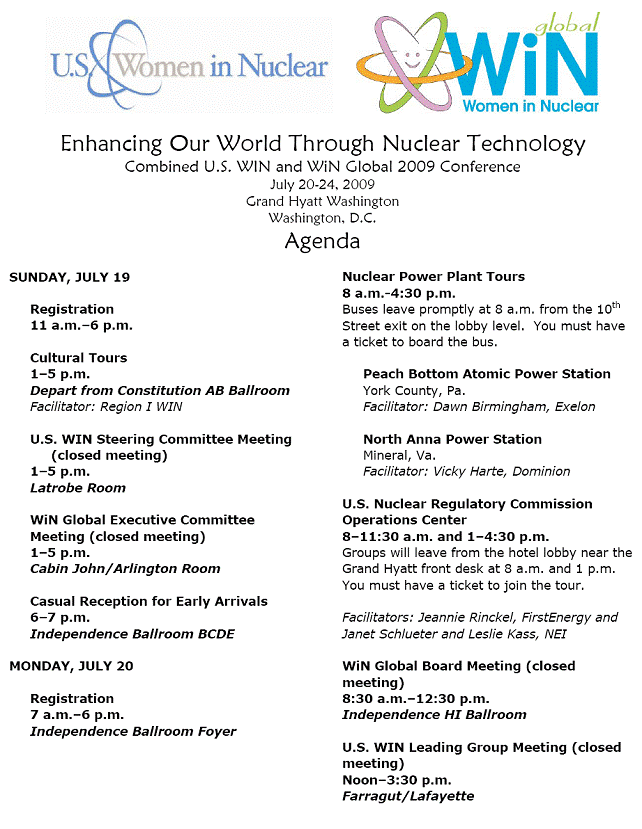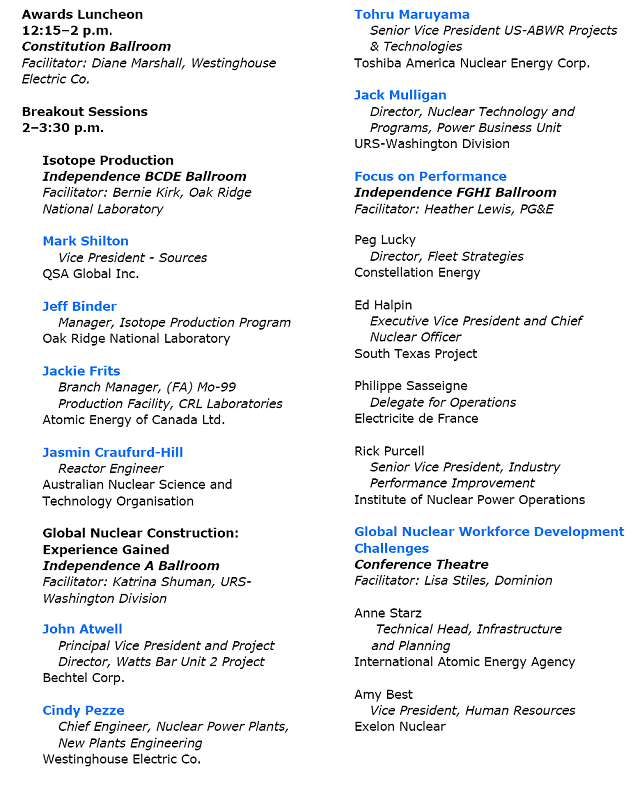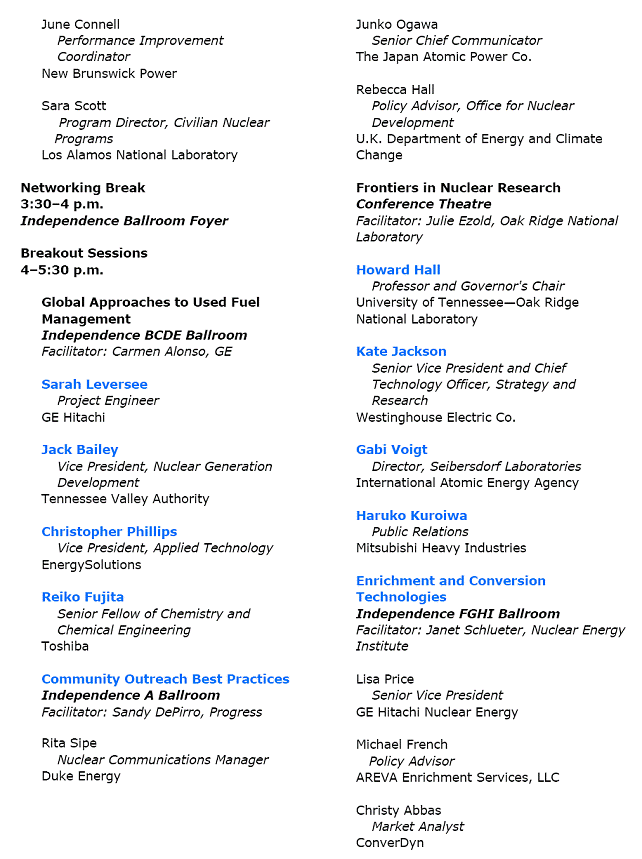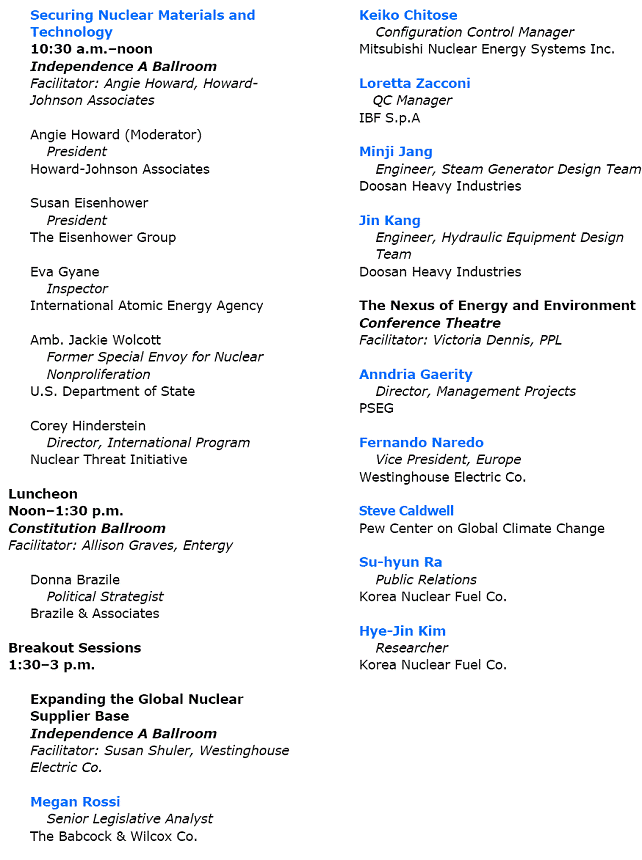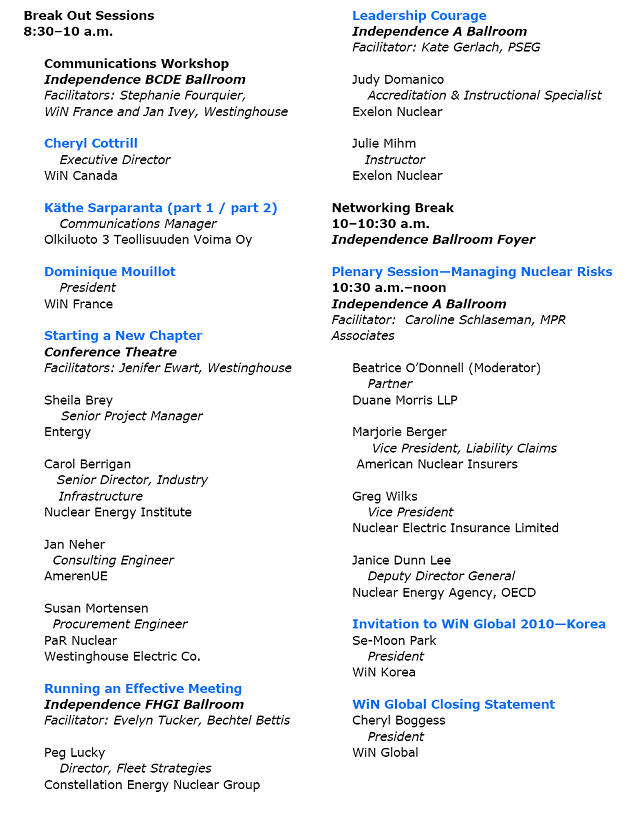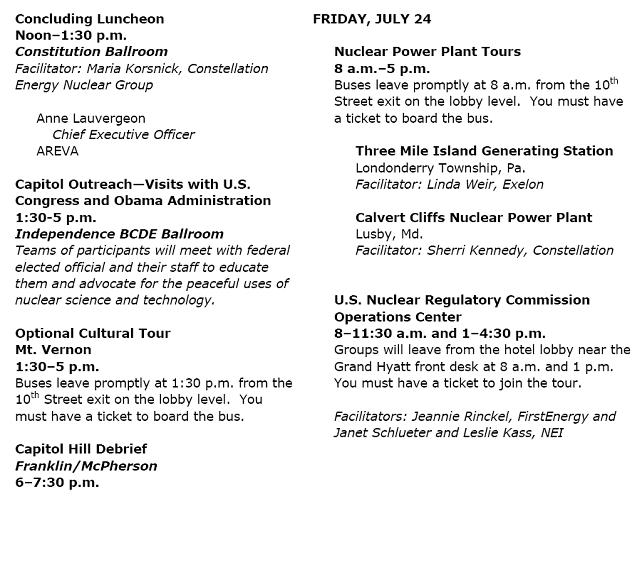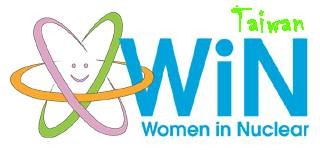 WiN Global 2009 年會(下)
WiN Global 2009 年會(下)
(四)、文化活動與其他
1.Capitol Steps表演(7月21日晚上)
Capitol Steps是非常有名的表演團體,由曾任職於國會的人組成,有說有唱,內容是諷刺政治人物、八卦笑話,如總統歐巴馬的笑話,非常美國式。但我們平常對美國的新聞知道不多,不能完全了解。
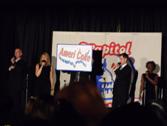


2.團體照:(7月21日黃昏)
在Constitution廳拍團體照(因大會尚未提供團體照,故未附照片)。
3.波多馬克遊河(7月21日晚上)
我們全體搭上了Spirit of Washington號,遊波多馬克河,遠遠可看到華盛頓紀念碑,船上有黑人唱歌,大家可自由交談。WiN U.S.預備了一個10週年蛋糕,慶祝一番。
白天炎熱的華府,在夜色中有清風徐來。
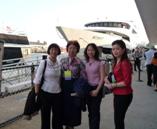
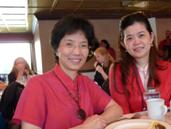
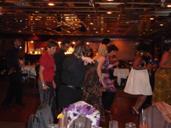
登船前留影 晚宴留影 晚宴中歡樂跳舞
4.邀請名家演講
此次大會特別在午餐時間安排三場演講,7/21中午為WiN Award得獎人感言;7/22中午為政治評論家Donna Brazile專題演講;7/23中午為 Areva 之CEO Ann Lauvergeon,Ann Lauvergeon曾於2005年獲得WiN Award,她是許多年輕學子的role model,有人問她如何做生涯規劃以便長大後擔任著名跨國企業的CEO?她說她年輕時未曾想過要擔任CEO。她也會有失敗,只是記取每一個經驗,繼續努力,她也感謝Areva給她機會,她認為核能大有可為,是解決能源與環境最主要的選項。這幾天參加會議中,她感受到核能界婦女們高昂的士氣。
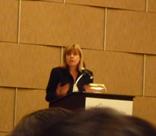
Areva CEO演講
5.安排參觀國會並與議員、總統府之官員對話
這個活動台灣代表團成員均未參加。
三、心得
1.目前WiN Taiwan在WiN Global各項活動中是相當活耀的,這個局面是因各核能機構及外交部的支持,希望能持續下去。
2.參訪三哩島核電廠2號機,讓我們親眼目睹使美國核能工業一蹶不振的地方,看到一座新新的電廠就這樣荒廢30年,使我們深切體悟沒有安全就沒有未來。我們亦學習到任何一件簡單的事都要以最高標準去完成它,方能減少事故發生的機率及降低事故的災害及損失,千萬不要掉以輕心。
3.我們在會議過程中吸收到很多訊息,如
(1)施工經驗及供應商—總共有8篇文章提到施工經驗及供產鍊,是台電正在做核四工程及未來新建機組的參考。
(2)溝通:全球核能婦女會Messaging Committee,針對不同的群組及主題編撰核能溝通宣導文宣資料,分為16歲以下的學童、16歲以上之學生與青年、一般民眾-與核電廠相關議題、一般民眾-核能應用相關議題、反核者及擁者等六大主題。把溝通所觸及的題目以淺顯易懂的文宣,針對各種年齡層,積極宣導輻射、核能等正確知識。可供我國作溝通之參考。
4.本次會議中美國鼓勵學生及新進員工參與,因此會場上很多年輕人,我國亦須積極規劃人才培訓計畫,以補足未來核能人力需求。
5.WiN Global很鼓勵role model,核能婦女界有很多卓越的人才,大會請Areva總裁Ann Lauvergeon演講,她曾於2005年獲得WiN Award,她是許多年輕學子的role model,有許多年輕人請教她如何成功。此外,Susan Landahl 亦回顧核能發展中有很多女性,如居禮夫人、吳建雄女士、1976年Robert Kankus是第一位女運轉員、Gale de Planque (1991年擔任NRC委員)…等,美國9000位元工程師,其中1000位元為女性,有7個國家之核管會主管為女性。核能界自開始以來就有許多卓越的女性在其中貢獻、耕耘,是我們引以為傲。
6.會議從頭到結束,大部分人全程參與,可感受到核能界婦女們高昂的士氣。
四、建議事項
1.此次年會中在7/22下午 Global Nuclear Workforce Development Challenges 分組討論,雖然台灣團無人參加此分組討論,但由會議資料可了解,核能可望成為未來幾十年的主流能源之一,會議由與談中均提及未來核能界的人力需求及挑戰。
此外,由相關文獻資料亦顯示,經濟合作暨發展組織(OECD)/核能署(NEA)各會員國已注意到現階段全球核能領域的人才缺乏,於2007年10月簽署的一份聲明書中表示,核能工業的生命循環長達100年,面對技術快速發展必須有高品質的研發人才,才能開發出新知識與新技術,以確保核能安全運轉。
因應國內核電與核能產業的發展,國內亦有必要檢視國際上因應核能復甦,在核能人才培育的努力現況,以及國內因應核能人才斷層及未來核電與核能產業發展人才需求。並積極規劃人才培訓計畫,以補足未來核能人力需求。
2.此次全球核能婦女會Messaging Committee,針對不同的群組及主題,編撰核能溝通教育文宣資料,分為16歲以下的學童、16歲以上之學生與青年、一般民眾-與核電廠相關議題、一般民眾-核能應用相關議題、反核者及擁核者等六大類別。目前僅有部分議題的資料草稿,仍招募志工積極投入,預定一年內完成,屆時每項資料背後均會有論點的科學根據或數據,極具參考價值。國內面對能源、核廢料處置等議題,亟需增進大眾的對相關議題的了解,核能界亦應積極彙整相關資訊,編撰正確、淺顯易懂的文宣,針對各年齡層積極提供輻射、核能等正確知識,擴大溝通與教育管道。
3.參訪三哩島核電廠,不僅讓我們了解三哩島事故真相,亦學習到對於任何可能的事故均要重視,千萬不要掉以輕心;任何一件簡單的事都要以最高標準去完成它,方能減少事故發生的機率及降低事故的災害與損失。
伍、附錄
一、WiN Taiwan country report
二、WiN Global 2009年會議程
附錄一 WiN Taiwan country report
 WiN Taiwan Country Report for the WiN Global Conference 2009
WiN Taiwan Country Report for the WiN Global Conference 2009
By Jessie J. Chiu
Atomic Energy Council
Taiwan ROC
Nuclear Overview in Taiwan
A. National Energy Policy-Nuclear as transition source of power
Soon after President Ma Ying-jeou took office on 20 May 2008, the new government passed a Sustainable Energy Policy Directive, calling for equal emphasis on “energy security”, “economic development”, and “environmental protection” in future energy development to ensure national security and a sustainable future. Following the goal of this Directive, the Executive Yuan launched the Third National Energy Conference to provide guidelines on the nation’s energy strategies. After dozens of pre-conference meetings held among all stakeholders in different regions on various subjects, the closing conference was conducted during 15-16 April 2009.
The conclusion of the conference outlined three major goals on future energy developments: to work toward a “low-carbon society”, to develop future economy, society, and environment based on new energy technology, and to coordinate government policies to reach the “low-carbon society”. Premier Liu Chao-shiuan took the position of viewing nuclear power as an important "transition source of power" to drive Taiwan toward a low-carbon society. He also committed the Government to intensifying guarantees for nuclear power safety, expediting the implementation of nuclear waste final disposal, and strengthening transparency and public oversight mechanisms.
B. Nuclear Power Plants and Performance
In 2008, 99.3% of Taiwan’s energy sources relied on imports. Electricity generation totalled 238.32 terawatt-hours (TWh) which was contributed by: coal 38.01%, co-gen 16.51%, LNG 20.04%, oil 4.80%, nuclear 17.13%, hydro 3.26% and wind &VP 0.25%.
Taiwan’s six existing nuclear power units, operated by the state owned utility Taiwan Power Company (TPC), generated a total of 40.83 terawatt-hours (TWh) of electricity (gross) in 2008 – a record high and up 0.7% from the previous year’s figure (40.54TWh). The three nuclear plants at Chinshan, Kuosheng and Maanshan, with two operating units at each site, provided a total installed capacity of 5,144 MWe, accounting for 11.09% of the total installed electricity capacity in 2008 – compared to 11.21% in 2007. They contributed a nuclear share of 17.13% to the total domestic electricity production last year– compared to 16.68% in 2007.
Performance wise, the average capacity factor for all six units in 2008 was 89.01%, the second best record in Taiwan’s nuclear power operation, slightly lower than the best record of 90.28% set in 2007. The annual average number of reportable abnormal events per unit was 2.17 (or 13 events for all six units), and the average number of automatic scrams per unit was 0.33 (or 2 scrams for all six units) in 2008. Production of solidified low-level radioactive waste from all six units totaled 253 drums, best record ever, down 1.6% from 257 drums in 2007 and down as much as 23% from 327 drums in 2006. A new record was also set at Unit 2 of Kuosheng plant for a refueling outage of 29.45 days, shortest for a TPC’s nuclear unit.
Construction continues at the fourth nuclear power plant “Lungmen” housing two ABWR units with 90% completion for construction and 35% completion for test runs as of 30 April 2009. The project had encountered significant delays due to the suspension in 2000, rising price of construction materials, finding new subcontractors to replace the bankrupted and negotiating new contracts to succeed the expired. Commercial operation dates set in 2006 were 2009 and 2010 for units 1 and 2, respectively, which have yet to be reset.
C. Highlights of Nuclear Regulatory and R&D Activities
Highlights of reactor regulatory activities conducted during the past 12 months include: 10-year integrated safety assessment for Chinshan Unit 1, continuing review of transient analysis methodology licensing applications, and a first-time maintenance rule inspection for all nuclear plants. For the Lungmen plant, focuses were on the pre-operation test inspection of pre-requisite systems and the initial test program and turnover process inspection. In the area of radiation protection, significant efforts were devoted to the implementation of the mammography quality control program, a special safety inspection of radiation sources at all academia and research institutes, and strengthening of self management in NDT radiation safety.
Major research focuses of the Institute of Nuclear Energy Research (INER) include: time limited comprehensive safety assessment for Chinshan NPP, nuclear power uprate for Chinshan and Maanshan NPPs, NPP license renewal related studies, development of D&D technology, commercial-grade item dedication for nuclear safety-related applications, development of fuel cells (SOFC and DMFC), cellulosic ethanol, high concentration photovoltaic (HCPV) systems, wind power generation systems, the integrated model of energy technology and macro-economy, and development and commercialization of radiopharmaceuticals. In addition, nearly 160 person-years were devoted to technical service activities for the completion of the Lungmen plant.
D. Radioactive Waste Management
On-site dry storage prior to final disposal has been recognized as a favorable option for the spent nuclear fuel management. An application for constructing a spent fuel dry storage facility at Chinshan plant was submitted by TPC in March 2007. After rounds of review by a technical review team, AEC’s Fuel Cycle and Materials Administration (FCMA) accepted the application and issued a construction license in December 2008. TPC is awaiting approval of its water and soil reservation plan by the county government before commencing the construction work.
As required by law, a candidate site for a low-level waste final disposal facility will be determined through a referendum in Taiwan. Following its announcement of three potential sites in August 2008, the Ministry of Economic Affairs (MOEA) further published in March 2009 a site selection committee’s report for public comment. The report recommended two of the three potential sites as “recommended candidate sites” to be located in Nantien village of Taitung County and Donguiyu Islet of Pescadores. The MOEA is expected to make a formal announcement on the recommended candidate sites by the end of 2009, taking into consideration of the comments received. A final “candidate site” will be determined through a referendum held at the counties where these “recommended candidate sites” are located. The county-level referendum is being planned for mid-year of 2010.
FCMA has also started on establishing a personnel qualification system for radioactive waste management, qualifying not only regulatory staff but also facility operators. The corresponding regulation was promulgated in April 2009, with sunset clauses to cease current practices in two years.
WiN Taiwan – Main Achievements in 2008/09
This part of the report has been prepared based on the four key elements of WiN Global’s strategic plan. WiN Taiwan’s activities and achievements as summarized below may fall under more than one of the key elements.
A. Organization – structure and sustainability
WiN Taiwan operates as a special division under the Chung Hwa Nuclear Society. Since its founding in 1994, members of WiN Taiwan have grown from 22 to 120 (among them, 37 are global members). WiN Taiwan has seven steering committee members by election, including chair and vice chair (i.e. president and vice president). The current (2008–2010) president and vice president are Jyi-Lan Wu of INER, and Shung-Hwui Fan of AEC, respectively. Past presidents who do not wish to be included in the ballots for election are invited to serve as advisors to WiN Taiwan.
WiN Taiwan finances itself, and as such seeks sponsorship for implementing special projects or activities. This year, WiN Taiwan accepted a grant to conduct a research project on communication and education. We have begun to benefit from preliminary results of this project, and will continue to explore opportunities of receiving grants for future research activities.
WiN Taiwan holds Steering and Advisory Committee meetings approximately every two months. Since January 2009, the issue of “whether to become a separate (independent) entity from its mother society” has been on the agenda of the meeting. Pros and cons were discussed, but no conclusion has been reached so far.
B. Benefits and Development – networking, training and education
WiN Global Annual Meeting-26~30 May 2008. A delegation of six members, led by WiN Taiwan President Dr. Shin Chang, attended the 16th WIN Global Annual Meeting held in Marseille, France. A poster on “Renaissance of Nuclear Energy in Taiwan” was on exhibit during the conference.
WiN Taiwan Annual Meeting-7 August 2008. WiN Taiwan and ANS-Taiwan Section held a Joint Annual Meeting at TPC’s Lungmen nuclear power plant. Two assemblies totaling 75 people joined together after separate business meetings to listen to two speeches. The first one was “Public Communication on Siting of a Final Disposal Facility for Low-Level Radioactive Waste” given by Chung-Cheng “Bruce” Lee, director of a special task force in TPC’s Public Services Department. The second speech was “Pulse Diagnosis and Health – Scientification of Traditional Chinese Medicine”, presented by Dr. Yu-Cheng Kuo, MD in both western and Chinese medicines, MS in pharmacy and PhD in biomedical-electrical engineering. Two field visits were organized for the afternoon: a site tour of the Lungmen Plant, and a guided tour at the Gold Ecological Park, site of an abandoned copper mine.
Exhibition at International Symposium-18~19 December 2008. WiN Taiwan set up a dissemination booth at the 4th International Symposium on Radiation Education. The exhibit includes posters, introductory pamphlets, and a continuous slide show of recent WiN activities. A total of 12 experts from Japan, Hungary, Thailand and Taiwan were invited to deliver speeches at the symposium, which attracted 140 participants. WiN Taiwan took the opportunity to gain exposure and reach out to young attendees.
Nuclear Symposium-20 December 2008. WiN Taiwan members took an active role in “the 2008 Taiwan-Japan Nuclear Symposium”, which was organized by the Nuclear Information Center, a non-profit organization. Eleven SNW (Senior Network) members of Japan’s Atomic Energy Society (AESJ) shared their experience in public outreach and school children education after retirement. Among the 100+ participants, half were college or graduate students. WiN Taiwan took the opportunity to network with SNW of AESJ, thereby helping strengthen the SNW of its mother society.
Spring Seminar-31 March 2009. Dr. Ming-fong Tai, professor at the Physics Department of the National Tsing Hua University was invited to give a talk on “Power Generation ~ Do it yourself!” The presentation with hands-on opportunity attracted more than 50 participants, including members and their colleagues. Two copies of a best seller “Hot, Flat, and Crowed” were given away in a drawing at the end of the seminar.
Preparation for Centennial Celebration-March 2009~. WiN Taiwan is taking part in organizing a 4-day conference of women scientists in early 2011 to celebrate the centennial of Taiwan ROC. Work has begun in nominating and inviting women scientists, domestic and abroad, of outstanding achievements in natural sciences, energy and engineering, and biosciences as speakers at the conference. About 500 attendees are expected, the majority of whom would be young generation.
C. Communication – strategies, tools and channels
Symposium/workshops on communication of nuclear issues-5~7 November 2008. WiN Taiwan hosted a symposium on Communication of Nuclear Power and Waste Disposal Issues on 6 November 2008. The full day conference focused on two themes: “Nuclear-a major option for future energy development in Taiwan?” in the morning, and “Finding home for low-level radioactive waste-role of the public” in the afternoon. About 120 people participated in this event.
Irene Aegerter, Founding President of WiN Global, and Se-Moon Park, Vice President of WiN Korea, were invited as special guests for the conference. They gave presentations on each respective subject, while two directors of TPC provided overview of the status in Taiwan. Eight panelists with expertise in economics, energy policy, environmental science and engineering, waste management, and physical planning and land use joined the discussion after the presentations. Members of WiN Taiwan served as session chairs and moderators.
The symposium was designed for professionals working in energy and nuclear related fields to learn lessons from Swiss and Korean cases and exchange experience regarding effective communication of nuclear issues. A number of NGO representatives were also among the participants. The symposium received very good reports and positive feedback from the participants. There was coverage of the event in both newspaper and internet news. Two workshops with roundtable discussion were also conducted before and after the symposium: Seismic Monitoring at Nuclear Power Plants, and LLW Disposal Siting and Public Communication. Through active discussions, a total of over 50 participants benefited from these workshops.
Research project on education and communication-2009. The project, entitled “Study on Education and Communication of Nuclear Energy by Professional Women in Nuclear Fields“, consists of three parts:
1) to study methods, extents, and results of education and communication on nuclear energy and radiation conducted by women professionals;
2) to develop teaching materials and tools and conduct seminars and workshops for K-12 students and teachers, collect feedbacks and perform evaluations; and
3) to set up a website to disseminate new energy technology and nuclear energy applications, which are readily usable by K-12 students and teachers as well as the general public.
Achievements for the second part of the project, which is further advanced than the other two parts, are summarized as follows:
Through the channels established for K-12 physics education programs, 22 seminars will have been delivered to K-12 students and teachers at their schools by the end of June, and 8 more have been scheduled for the fall semester. Over 20 nuclear energy and radiation related subjects are available for the school to specify under the “Let’s talk about energy and atomic science!” series activities. Additional 10-20 seminars are being planned for the fall semester pending availability of additional funding.
A 3-hour teaching module “Nuclear Power–our invisible friend” has been developed and is ready to be presented by WiN Taiwan members at summer camps. The module consists of three components: understanding the basics using a video or interactive CD and checking on delivery with a bingo game, building and operating a nuclear power plant through role playing, and looking for the invisible friends (ionizing and non-ionizing radiation) using a variety of radiation detection instrument.
Another 3-hour education program “Visiting the Reactor at Tsing Hua” has been developed and successfully tested in May by 30 Grade-10 female students gifted in science. The program, consisting of lecture, hands-on exercise and touring of the facility, will be offered to high school students once a month throughout the remainder of the year.
Related activity
As one of the K-12 activities sponsored by the National Science Council in celebrating its 50th Anniversary, WiN Taiwan, in cooperation with the Physics Department of the National Tsing Hua University, has been conducting a one-day science and technology excursion once a month. The subject for the spring (February through April) months was “exploring energy and nanotechnology”, which covered basic theories and applications of reactors, the history and touring of Tsing Hua’s open-pool research reactor, and lecture/DIY/discussion of solar cells. A total of over 200 of diversified age and background participated in the first three excursions.
WiNFO. WiN Taiwan sees WiNFO as not only a networking tool among global WiNners but an excellent source of ideas for developing its own strategic plan, especially communication activities. While enjoying this benefit from WiN Global and its chapters around the world, we have committed ourselves to fulfilling reciprocal obligations. Recent contributions have appeared in three of the latest four issues of WiNFO.
D. Looking Ahead – Upcoming activities
WiN Taiwan Annual Meeting-8 July 2009. The 2009 WIN Taiwan Annual Meeting will be held jointly with the ANS - Taiwan Section at the Institute of the Nuclear Energy Research. Technical and cultural tours will be conducted in the afternoon following the business meetings and joint seminars.
WIN Global Annual Meeting-20~24 July 2009. A delegation of six will be attending the 17th WIN Global Annual Meeting in Washington DC, USA.
Power Generation Summer Camps-July~August 2009. As part of a summer camp series on Energy Technology and Application offered at the National Science Education Center (NSEC), four 2-day camps on power generation will be provided to children of Grades 5-6 and Grades 7-8 separately during the summer months. WiN Taiwan will present the newly developed teaching module “Nuclear Power–our invisible friend” during each camp.
Science Fair-25 July 25 ~01 August 2009. This is another summer K-12 activity organized by the NSEC to be held at an athletic park in Jia-yi County. WiN Taiwan, sponsored by the AEC, will be running two stands “Who’s the Nuclear Knowledge King” and “Monsters Inc” as well as a demonstration on “How much do you know about radiation” which will be presented twice a day.
Science education workshop-September 2009~. Possibilities are being explored with the NSEC to continue offering the same teaching module as a weekly workshop through the remainder of the year.
One-hour teaching modules-September 2009~. A series of one-hour teaching modules on various nuclear energy and radiation topics will be developed for use by K-12 teachers.
Networking with Women Scientists-31 October~1 November 2009. For the first time, WiN Taiwan has been invited to attend the 6th Female Physicists and Chemists Joint Symposium and to introduce WiN to the participants. Female members of the physics and chemistry learned societies take turns to host the biannual event. This time the symposium is being organized by women chemists.
WiN Taiwan country report簡報
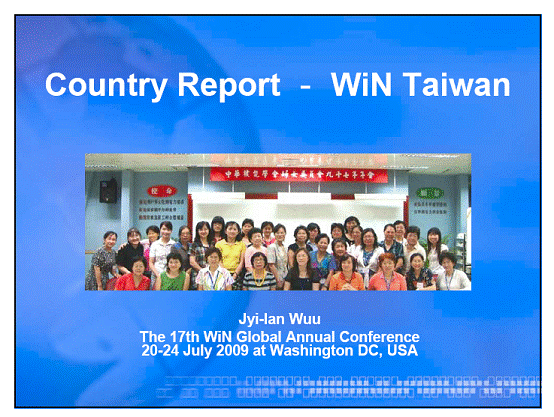

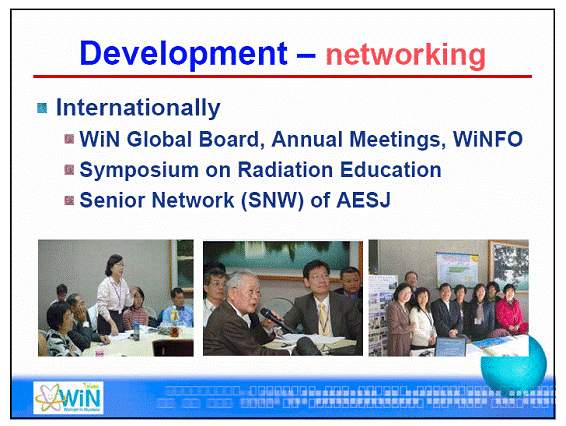
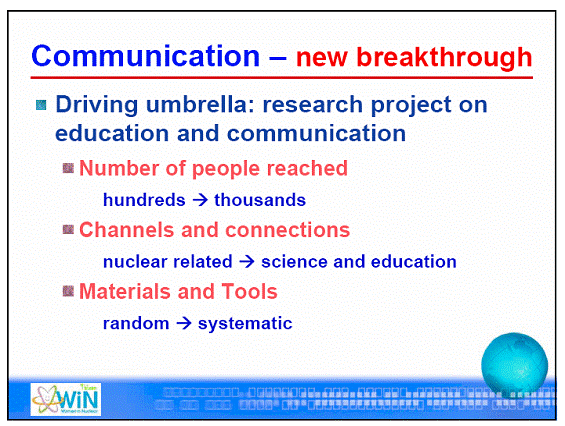
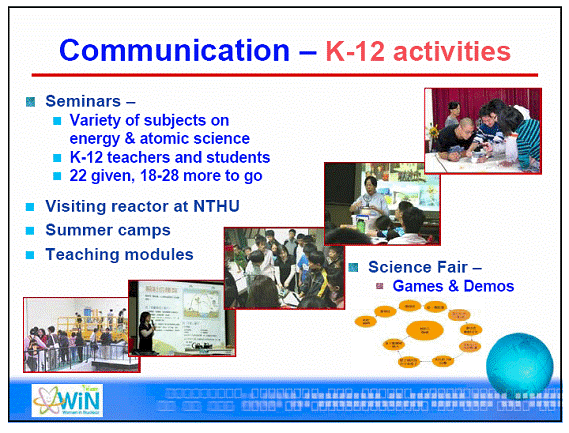
附錄二WiN Global 2009年會議程
